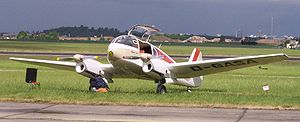Aero 145
| Ae 45 | |
|---|---|
 |
|
| Let Aero Ae 145 | |
| Role | Utility aircraft |
| Manufacturer | Aero Vodochody, Let |
| First flight | 21 July 1947 |
| Primary users |
Czechoslovakia China Hungary Soviet Union |
| Produced | 1951–1963 |
| Number built | 590 |
The Aero 45 was a twin-piston engined civil utility aircraft produced in Czechoslovakia after World War II. It was the first product of the nation's postwar aviation industry and proved a great success, with many of the 590 produced being exported.
The development began 1946 and was accomplished by the technical designers Jiři Bouzek, Ondřej Němec and František Vik. The design bears a superficial resemblance, viewed nose-on, to the German Siebel Si-204 which, among other German aircraft like the Bf 109, were produced in Czechoslovakia while under German occupation. The prototype (registered OK-BCA) flew for the first time on 21 July 1947, the second, registered OK-CDA, one year later. Flight testing ran without incidents and the type was released for series production in 1948. The model number of "45" was not a continuation of Aero's pre-war numeration scheme, but a reference to the 4/5 seats in the aircraft.
Ae-45 prototypes were widely advertised abroad. In August 1949 Jan Anderle won the Norton Griffiths Race in Great Britain (Ae-45 registration OK-DCL). They also set several international records. As a result, apart from Eastern Bloc countries, the plane was also bought by Italy and Switzerland. On 10–11 August 1958 Dr. Pier Paolo Brielli flew an Italian Ae-45 3000 kilometers from South America to Dakar across the southern Atlantic (as the first Czechoslovak-built aircraft). In 1981 Jon Svensen flew Ae-45S from Europe to the USA.
This type was used in Czechoslovakia and was exported to the People's Republic of China, East Germany, France, Hungary, Italy, Poland, Romania, Soviet Union and Switzerland. Hungary was a major customer, where the aircraft was known as the Kócsag (Hungarian: "Egret").
...
Wikipedia
